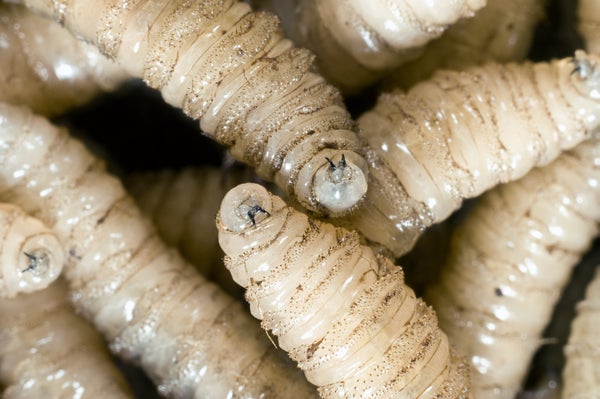August 25, 2025
4 min read
Human Case of Flesh-Eating Screwworms Detected In U.S.
This gruesome parasite is more of a threat to your burger than to you

Screw-worm fly (Cochliomyia hominivorax) larvae use their sharp mandibles to dig into and eat away the living tissue of warm-blooded animals, including humans.
Philippe Psaila/Science Source
Just two months after reports warily noted that new world screwworms, flesh-eating parasites that are notorious for killing livestock, pets and other animals, hadn’t “made it back into the U.S. yet,” they have—in the form of the country’s first human infection from the current outbreak in Central America. Screwworm larvae hitched a ride inside a person who had recently been to El Salvador, according to the Department of Health and Human Services.
The patient, a resident of Maryland, has been treated, and the threat to other people is low. “A human coming back with [larvae] is generally not going to lead to an outbreak because those humans are going to go get treated,” says veterinary entomologist Sonja L. Swiger of Texas A&M University. “These larvae are horrible. They eat your body, literally.”
The real danger is to livestock. The new world screwworm has been spreading steadily northward from Central America, mainly by traveling in infected animals, and poses a major threat to the U.S. meat industry. Last week Secretary of Health and Human Services Robert F. Kennedy, Jr., determined that the advancing parasite signaled a “significant potential for a public health emergency” that could threaten national security, according to an HHS notice.
On supporting science journalism
If you’re enjoying this article, consider supporting our award-winning journalism by subscribing. By purchasing a subscription you are helping to ensure the future of impactful stories about the discoveries and ideas shaping our world today.
What is a screwworm?
Screwworms are the larvae of the fly Cochliomyia hominivorax, which lays up to 300 of them at a time inside open wounds or tender parts, such as the mouth, of warm-blooded animals. Once they hatch, the larvae corkscrew their way through living flesh as they consume it, causing extreme pain or, if left untreated, even death. After three to seven days, the larvae fall to the ground and burrow into the soil to pupate, transforming into flies. A female fly mates only once and carries around the sperm to lay about 3,000 eggs in her lifespan of up to 30 days.
How are screwworm infestations treated?
The best treatment is avoidance. Because the flies are attracted to open wounds—even something tiny such as a tick bite, according to the Centers for Disease Control and Prevention—people should cover all wounds, especially when sleeping outdoors, working near cattle or traveling in infected areas. Although the adult flies aren’t known to be in the U.S. yet, they are in southern Mexico.
If you suspect you have been attacked or infected, see a physician right away. The worms may be visible in the wounds. Each individual organism must be carefully extracted, which may require surgery. Currently, there are no drugs approved by the Food and Drug Administration for treating screwworm infestations.
Kennedy did declare, however, that the FDA can fast-track approval processes for antiparasitic drugs to be used in animals with screwworm infestations. (No cases from the current outbreak have been detected in animals in the U.S.) The FDA’s Center for Veterinary Medicine is now working with makers of animal drugs to identify promising medications. Veterinarians may also use drugs that are approved for other uses to treat screwworm infestations.
Can the northward march of the screwworm be stopped?
The screwworm was eliminated in U.S. in the 1960s by breeding millions of male flies, sterilizing them with radiation and releasing them into the wild to mate with females—which would then fail to reproduce because they would mate only once in their lifetime. Millions of sterile male flies continue to be released in Central America, thanks to a breeding facility in Panama that the country runs jointly with the U.S. Department of Agriculture. In recent months, the USDA has announced funds to retrofit a similar plant in Mexico and to modify or build plants to breed sterile flies in the U.S. as well. At the same time, scientists are experimenting with genetic engineering to create a mutation that will be passed on through screwworm eggs and sperm cells and kill the next generation.
“We have folks in Texas who have dealt with it, and they will tell you, ‘You don’t want it back,’” Swiger says. “It is a game changer for livestock impact, and those are the animals we can control.” If the parasites infect wild animals such as deer, that will have “huge impact,” she adds. In Texas or Florida, screwworms could persist year-round.
Experts fear that the flies could enter the U.S. by means of infected animals that are transported close to or into the country. “The flies themselves don’t travel more than 12 miles” during their lifespan,” Swiger says. “So they can’t pick up and leave a Central American country and get here on their own.” Some regulations have been put in place to constrain the transport of animals from infected regions. Imports of cattle, horses and bison from Mexico have been suspended by the USDA since May, for example. “Humans need to know that we are the impact,” Swiger says, and act accordingly to block the screwworm’s travels.
It’s Time to Stand Up for Science
If you enjoyed this article, I’d like to ask for your support. Scientific American has served as an advocate for science and industry for 180 years, and right now may be the most critical moment in that two-century history.
I’ve been a Scientific American subscriber since I was 12 years old, and it helped shape the way I look at the world. SciAm always educates and delights me, and inspires a sense of awe for our vast, beautiful universe. I hope it does that for you, too.
If you subscribe to Scientific American, you help ensure that our coverage is centered on meaningful research and discovery; that we have the resources to report on the decisions that threaten labs across the U.S.; and that we support both budding and working scientists at a time when the value of science itself too often goes unrecognized.
In return, you get essential news, captivating podcasts, brilliant infographics, can’t-miss newsletters, must-watch videos, challenging games, and the science world’s best writing and reporting.
There has never been a more important time for us to stand up and show why science matters. I hope you’ll support us in that mission.









